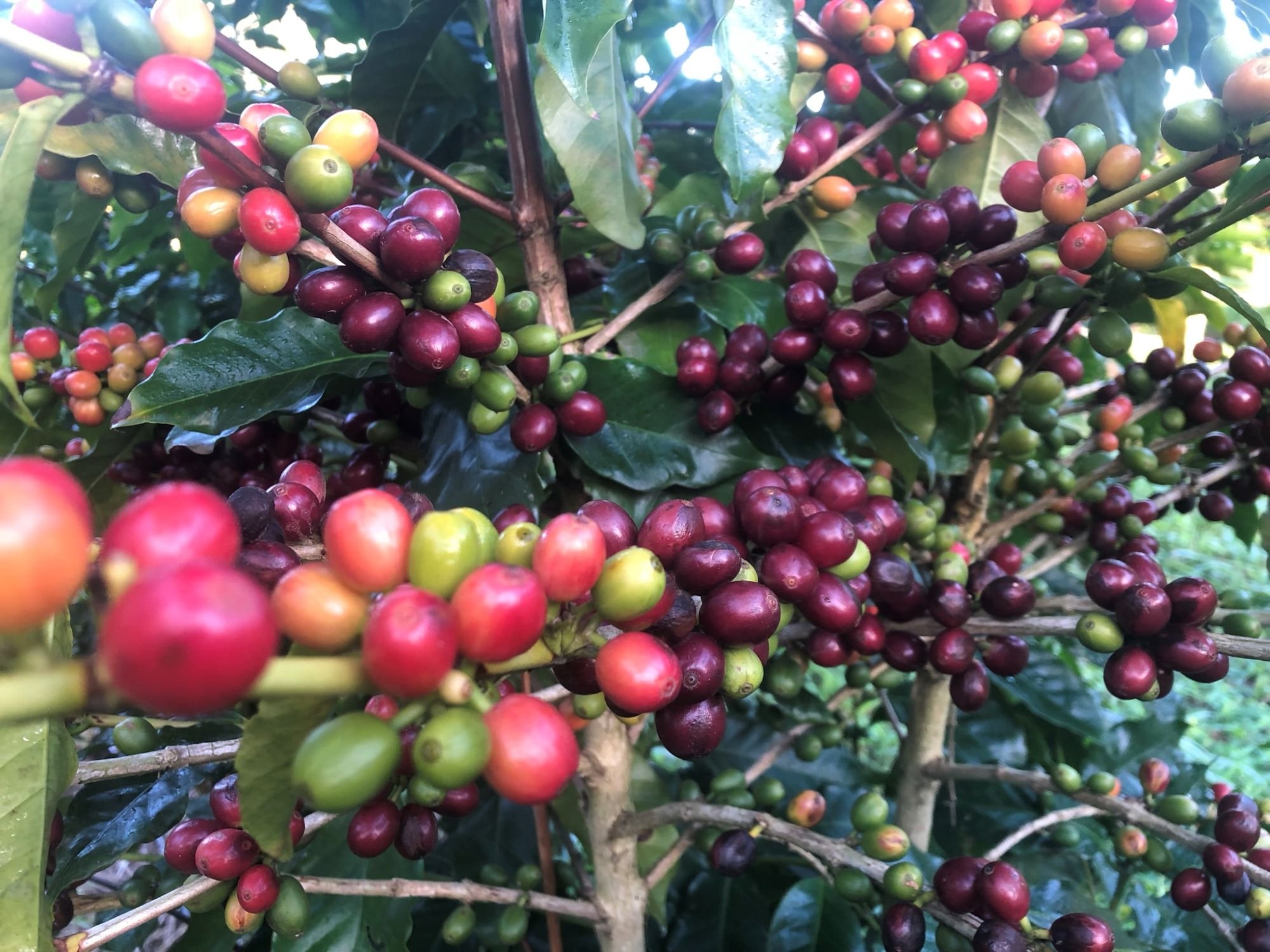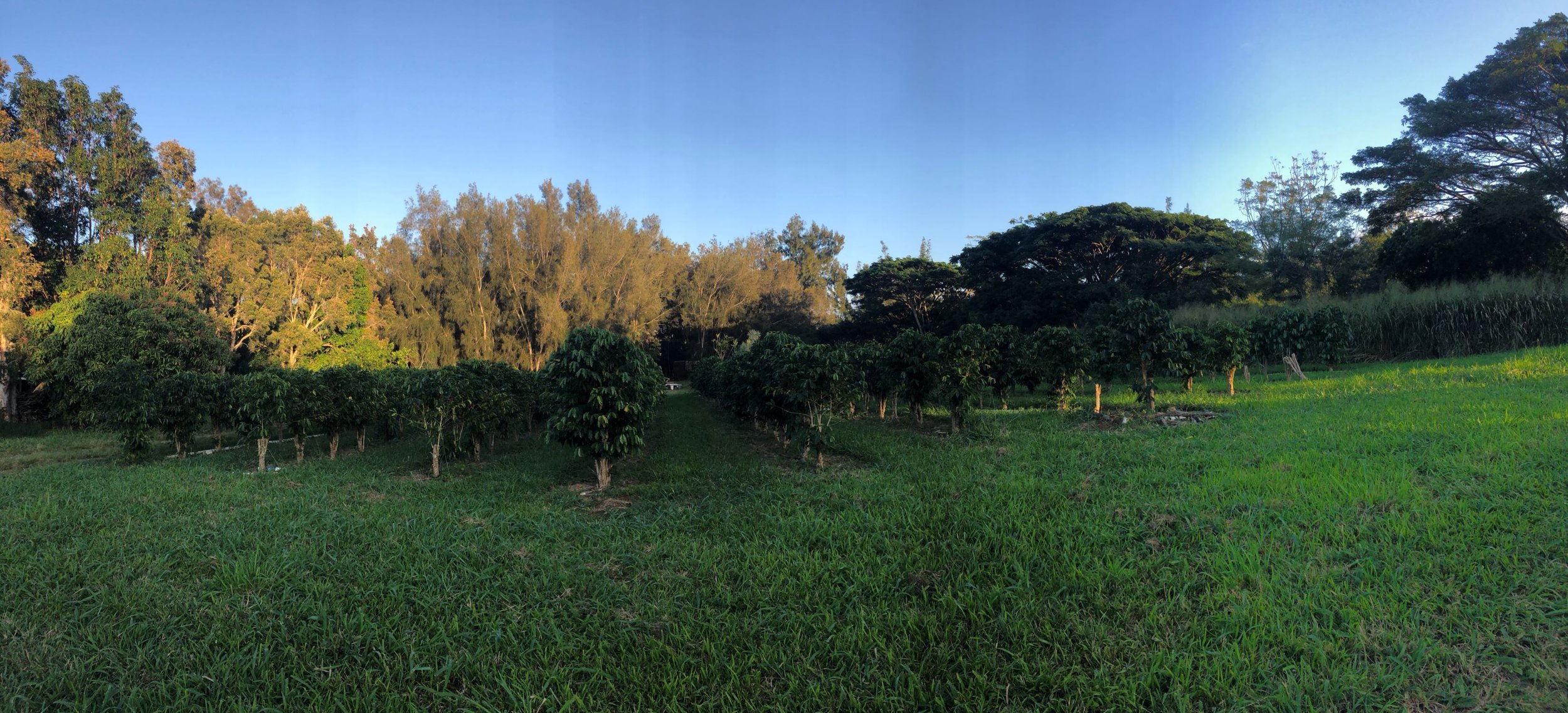Coffee Time—Dawn to Dusk in the Grocery Store or Coffee-Tree Orchard
Would you agree that a back muscle stretches when reaching on the grocery store shelf? I can picture you pulling a plastic tub, maybe Folgers or another popular consumer selection, from up high. Or perhaps right there on the middle shelf is a well-designed bag of expensive coffee, still whole bean, yet to be ground. Whether high-quantity brands like Folgers or high-quality boutique small-batch coffee labels, the bean starts on a thriving tree. And I am standing smack dab in a tree orchard in rural Hawi on Big Island Hawai’i. You know, where the coffee bean originates?
You reach high on the grocery store shelf for coffee, and I reach high on the tree to pick coffee beans. One curious question drops down from each reach. Do we know who harvests coffee and where, before the bean arrives to the shelf? Many thorough books dive into coffee history, politics, culture, and ethics. Yet this writing stays lopsided in that these are simply experiential notes on harvesting coffee because I have the chance.
Given the recent life electrical currents that I run on, as in privilege to live well on a frugal budget, picking coffee beans in the Hawai’i sun for eight hours a day/five days a week or more, or harvesting coffee anywhere around the world, is not required for me. Yet clearly, for some other good peoples, to bring Folgers or barista coffees to the American grocery store shelf, it is. My guess is that most of the coffee we drink around the world arrives from laborers needing the work.
Yet for me on this one 24-hour day, I scoot close to the tree, listening to her cues—the way nature teaches us to follow. The main strategy is the pause button—as in taking a few extra minutes standing in the grocery story to turn the coffee bag, can, or bucket around to learn its pathways, some origins in politics and culture. Labels can reveal even if they hide food backstory, too. Becomes a sort of food-literacy to decode. Reading nature’s signals also takes patience and selected focus. Then in the tree orchard, I too move carefully slow to harvest the bean in alliance with the tree—either way, we pause.
Wondering can happen standing in a coffee-bean tree orchard outdoors or grocery store indoors equally well. And I suggest we owe it to ourselves and to nature’s environment to keep doing that. Slow pause moments for choosing to stay curious about coffee, now, and perhaps extend this curiosity to whatever we eat throughout one 24-hour day.
Imagine that instead of grocery store fluorescent lights overhead and polished cement floor beneath your feet, the surround sound system brings chirping birds (random volumes of squawking) and walkers passing by on a dirt pebbled road, in exuberant conversation, maybe giddy on coffee and fresh air. The 7 a.m. morning air still has chilly wind in the shade and pronounced warm light in direct sunshine. Inhaling air next to a coffee tree smells like a whisp of dark green leaf, maybe pine needles, and then sweet pheromones of some flower you know, those hints of strawberry and rose petal. That is the deep red coffee bean ready for harvest.
Starting to harvest this morning, even hiking shoes, the thick material, are drenched by morning dew. Walking on country grass, just a few steps to the coffee trees where I will work for a short while picking the ripe beans, already my socks are soaked through and through. This Kohala region has cool-cool evening weather, in the low 60s Fahrenheit overnight. Temperature change in the tropics is one of the more dramatic overnight transformations that creates a type of watering for the trees. Feels calming, even spirit-nourishing for me as a human, to see the moisture on surrounding grasses and the leaves on the coffee trees enjoy the cool shower, a tall glass of clear water quenching coffee tree thirst. In one 24-hour cycle, the aina (land) experiences momentous change when seen from the perspective of one blade of grass or one leaf or one coffee bean.
And this human appreciates cooler morning temps, too, since Hawai’i tropics can throw heat, for sure. Hassle for sure that shoes and socks are totally watered down yet imagine nature’s work, what has transpired since I fell asleep last night around 9:30 p.m. The myriad coffee tree chemical reactions that occur in concert overnight, working hard to bear fruit, what is known as the coffee cherry. By 5:30 a.m. the temperature warms a few degrees maybe 62F to 64F. Still pitch dark, the stars flick like crystal clear flashlights miles and miles distant yet feeling close, an intimate morning start. Then sun rise by 6 a.m. brings feint grey-blue light on the horizon until more steady sunshine scrolls up. The coffee trees are soaked in water from last night’s cooler temps as the brilliant bright sunshine bears down on their leaves by 7 a.m.
The leaves flop differently now, a new work shift has begun, as coffee trees are putting in extra energy to accommodate the increasing heat. By 8:30 a.m., as I reach for branches, gently cajoling them this and that way, the leaves are dry. Direct sunshine Hawai’i style beams continuous heat now. Even so the coffee trees glisten radiance from their night shift, the continuing work to grow coffee bean that I harvest.
Maybe my human role is to pick the bean, lighten the tree’s load, and so gratefully accept the reward. In a way, how I listen to the tree is like how I listen to a product on a grocery store shelf. I wish to be more than a consumer. I am in a food ecosystem relationship, and my part is simply to pay attention—and even an often-distracted soul as myself can do that.
What I intuit in my own work, meaning staying aware of my part, is that picking coffee beans when the sun rises at dawn seems best for the plant, and this human. Imagine the entire rest of the day, being a coffee tree, those long hours up to dusk, absorbing all that nourishing sunshine with a much lighter weight since the product, the incredible tasting coffee bean, has been lifted away.
And I am learning that the opposite is true, too. If the bean never leaves the limb, the ecosystem message we humans send to the tree, or, rather do not convey, is that we no need the bean. Then the bean shrivels, dries up in the hot sun, and the tree produces fewer coffee beans along the way. If the aina gifts me the chance to live on the soil, seems least I can do is reciprocate by harvesting some coffee over a few volunteer work hours.
Nurturing food “products” in the grocery store feels similar. Brands that consumers pay attention to will thrive. Seems such a simple concept that you and I keep food companies in business based on conscious shopping. As we can cultivate thriving trees growing on this earth, we can also support human healthy and environment friendly grocery story selections.
Back to my messy human life and the coffee trees, I admit that sometimes I harvest at dusk rather than dawn. The routine is not always there. Looking at them around 5 p.m. the coffee trees seem droopy, ready for the return to cooler weather in their 24-hour adventure. A dry leaf crumbles on one branch and a limb needs spontaneous pruning as the tip turns grey. At this dusk time my shoes stay dry, and I move just slowly given the heat even late in the day. Working until the branch before me is not visible in the dark, a nighttime hour now, and the day starts to close. I can return at dawn to begin again.


